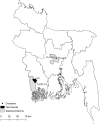High coverage and equitable distribution of COVID-19 vaccine uptake in two vulnerable areas in Bangladesh
- PMID: 39823518
- PMCID: PMC11741643
- DOI: 10.1371/journal.pgph.0004178
High coverage and equitable distribution of COVID-19 vaccine uptake in two vulnerable areas in Bangladesh
Abstract
Bangladesh completed a primary series of COVID-19 vaccinations for about 86 individuals per 100 population as of 5 July 2023. However, ensuring higher coverage in vulnerable areas is challenging. We report on the COVID-19 vaccine uptake and associated factors among adults in two vulnerable areas in Bangladesh. We conducted a cross-sectional study between August and September 2022 in Duaripara, a slum in northeast Dhaka (in-migration site), and Tala, a disaster-prone sub-district in southwest Satkhira (out-migration site). We surveyed 1,239 adults in Duaripara and 1,263 adults in Tala from 625 and 596 randomly selected households, respectively. We reported coverage and examined associations between the uptake and demographic and socioeconomic characteristics using multilevel mixed-effects generalized linear regression models. We checked for spatial autocorrelation to assess geographical patterns in vaccine distribution. First- and second-dose coverage was about 91% and 80.4% in Duaripara and 96.6% and 92.2% in Tala, respectively. Individuals above 40 were more likely to be vaccinated (IRR: 1.12, p-value = 0.04 for Duaripara, and IRR: 1.14, p-value <0.01 for Tala). Professions requiring more outdoor interactions had a higher likelihood of receiving the vaccine. In Tala, television access (IRR: 2.09, p-value <0.01) and micro-credit membership (IRR: 1.50, p-value = 0.05) were positively associated with receiving a booster dose and negatively associated with smart-phone access (IRR: 0.58, p-value = 0.03). Moreover, temporarily migrated respondents were more likely to be unvaccinated (IRR: 0.87, p-value = 0.04). Income was not associated, indicating equitable distribution. Moreover, no geographical clustering was detected. The credit for high COVID-19 vaccine coverage in Bangladesh can be attributed to the country's longstanding success in implementing immunization programs, which relied on community mobilization and effective health education to generate demand. However, to ensure comprehensive coverage in vulnerable areas, targeted interventions can help increase uptake by addressing specific sociodemographic differences.
Copyright: © 2025 Islam et al. This is an open access article distributed under the terms of the Creative Commons Attribution License, which permits unrestricted use, distribution, and reproduction in any medium, provided the original author and source are credited.
Conflict of interest statement
The authors have declared that no competing interests exists.
Figures



Similar articles
-
Inequities in COVID-19 vaccine and booster coverage across Massachusetts ZIP codes after the emergence of Omicron: A population-based cross-sectional study.PLoS Med. 2023 Jan 31;20(1):e1004167. doi: 10.1371/journal.pmed.1004167. eCollection 2023 Jan. PLoS Med. 2023. PMID: 36719864 Free PMC article.
-
Integrating routine immunization into COVID-19 vaccination improve coverage but could create equity issues: evidence from Niger State, Nigeria.BMC Public Health. 2025 Apr 22;25(1):1490. doi: 10.1186/s12889-025-22796-z. BMC Public Health. 2025. PMID: 40264059 Free PMC article.
-
Socioeconomic drivers of vaccine uptake: An analysis of the data of a geographically defined cluster randomized cholera vaccine trial in Bangladesh.Vaccine. 2018 Jul 25;36(31):4742-4749. doi: 10.1016/j.vaccine.2018.04.084. Epub 2018 May 8. Vaccine. 2018. PMID: 29752024 Free PMC article. Clinical Trial.
-
Striving for equitable vaccination coverage: Leveraging rapid coverage and community assessments during the COVID-19 pandemic to reach missed populations in Cambodia.Vaccine. 2024 Nov 14;42 Suppl 5:126016. doi: 10.1016/j.vaccine.2024.05.064. Epub 2024 Jun 8. Vaccine. 2024. PMID: 38852038
-
Number of tetanus toxoid injections before birth and associated factors among pregnant women in low and middle income countries: Negative binomial poisson regression.Hum Vaccin Immunother. 2024 Dec 31;20(1):2352905. doi: 10.1080/21645515.2024.2352905. Epub 2024 May 21. Hum Vaccin Immunother. 2024. PMID: 38772729 Free PMC article. Review.
References
-
- Johns Hopkins University & Medicine. Coronavirus resource center. 2023. Available from: https://coronavirus.jhu.edu/region/bangladesh
-
- Bardosh K. How did the COVID pandemic response harm society? A global evaluation and state of knowledge review (2020-21). SSRN J. 2023. doi: 10.2139/ssrn.4447806 - DOI
LinkOut - more resources
Full Text Sources
